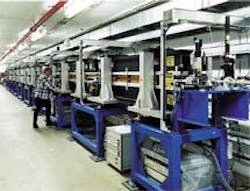Mirrorless FEL achieves 'saturated' emission
A team of scientists and researchers at the US Department of Energy's Argonne National Laboratory (Argonne, IL) has achieved saturation of self-amplified spontaneous emission in a mirrorless, single-pass free-electron laser (FEL)—at a wavelength more than 1,000 times shorter than the previous record from a mirrorless FEL of its kind. The team demonstrated the predicted exponential growth and saturation at wavelengths in the visible (530 nm) and ultraviolet (385 nm). Led by Stephen Milton and Efim Gluskin, the researchers reported that the process has moved them a step closer toward an operational x-ray FEL.
"In the history of synchrotron radiation research, which is only about 45 years old, you can count the true breakthroughs on the fingers of one hand," said David Moncton, Argonne's associate laboratory director of the Advanced Photon Source. "This is one of them."
Unlike conventional lasers, Argonne's mirrorless FEL uses the combination of a powerful electron accelerator and an undulator (a long array of very precise magnets of alternating polarity) for operation (see figure). When an electron beam passes through the magnets, they emit light as synchrotron radiation. As electron bunches propagate down the undulator, they are bathed in the same energy they generate. The electrons, depending on their phase relationship with the light and the magnetic fields, gain energy and speed up or lose energy and slow down. As a result, the electrons form microbunches separated by a distance equal to the wavelength of the light they generate. Light waves emitted by the electrons line up in phase, and eventually a favorable runaway instability develops. The light intensity grows exponentially along the undulator until the process saturates. When the light beam emerges, its initial intensity has been amplified more than a billion times.
By merely changing the FEL's electron beam energy, it is continuously tunable over a broad range of wavelengths. At high enough electron energies and with an adequately long undulator system, a FEL could theoretically produce an x-ray beam with peak brightness more than 1 billion times greater than the brightest x-ray beams available today.
With further development, FELs of this sort promise to provide extremely bright, laser-like x-ray beams with ultrashort pulse durations that will enable scientists to study the properties and structures of materials in far greater detail and less time than currently possible. Applications include snapshots or "movies" of chemical and biological reactions too fast to be observed with today's sources; holographic images of proteins and other molecules; obtaining an image of a single protein with a single x-ray pulse; and the ability to study "warm, dense matter," a state between one in which all of the electrons surrounding a collection of atoms have become so excited that the electrons are stripped from the atoms and the whole collection becomes a hot plasma.
"We plan to go to 120 nm this summer, and expect to go to much shorter wavelengths—possibly 60 nm—and so show the tunability of this laser over a broad range," said Milton.
About the Author
Sally Cole Johnson
Editor in Chief
Sally Cole Johnson, Laser Focus World’s editor in chief, is a science and technology journalist who specializes in physics and semiconductors.

